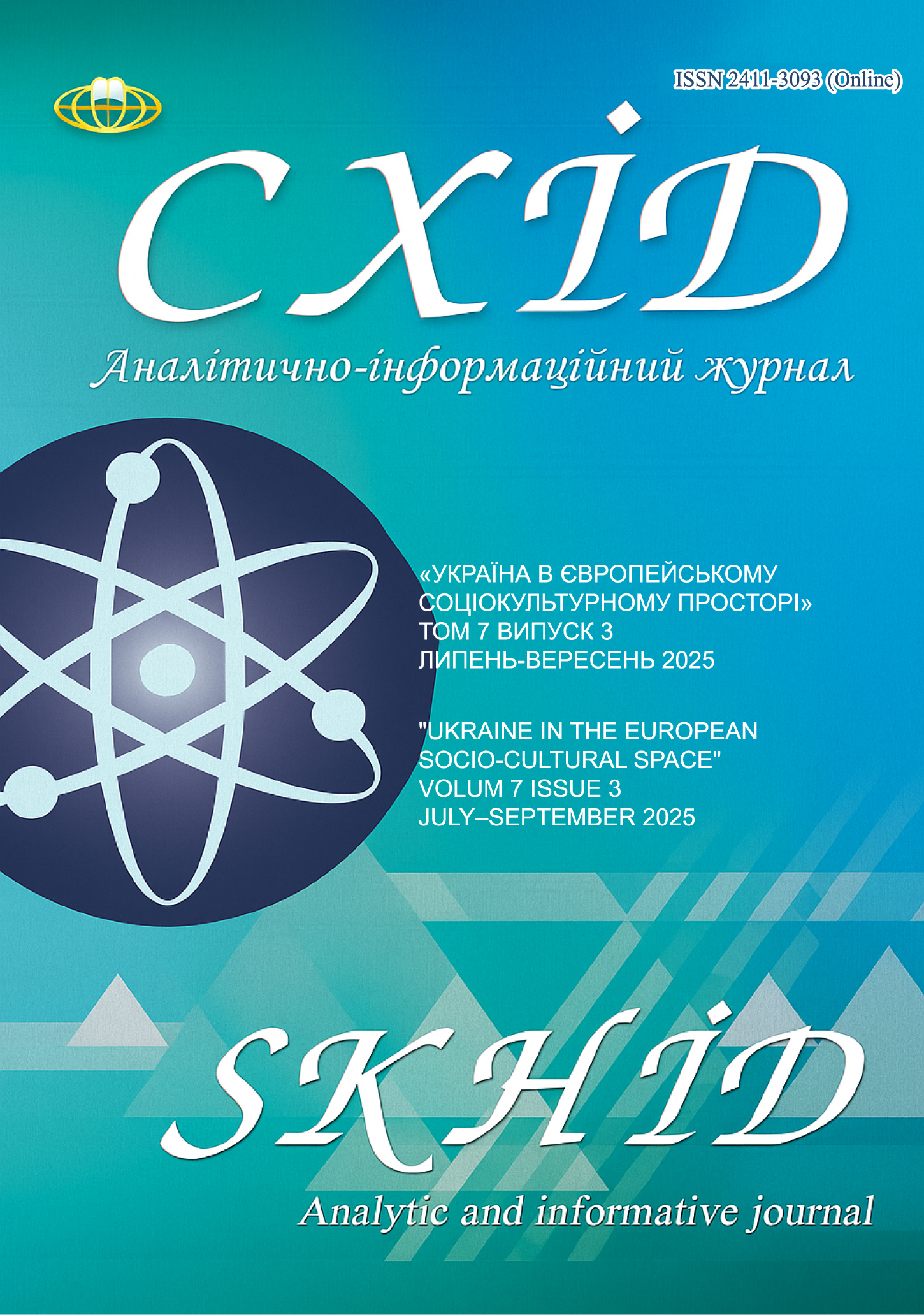Natural Environment and its Influence on the Psyche of the Ukrainian Ethnos
DOI:
https://doi.org/10.21847/2411-3093.2025.734Keywords:
environment, archetype, flora, fauna, ethnopsychology, mentality, Ukraine, Europe, Ukrainian studiesAbstract
The article is devoted to determining the role of the natural environment in shaping the mental foundations of the Ukrainian ethnos. It is argued that a specific locality in Europe determines the psycho-ethnic basis of Ukrainian society, which undergoes a multi-vector genesis precisely in the special natural conditions of ‘the integrity of space and time.’ The geopsychological influence of the biogeographical and specific biocenotic environment on the somatopsychic state of the human mind and the regional features of such influence, which are manifested in specific ethnic psychotypology, have been determined. These psychotypological characteristics are embodied in the way of thinking of representatives of certain communities, which today is referred to as “mentality”. We approach these states of the human psyche after coming from the archetypal foundations or prototypes of the human mentality. Therefore, we move on from various archetypal foundations that significantly influence the peculiarities of behaviour and economic activity (in particular, archetypes “man-plant” and “man-animal”) to the consideration of societies dominated by the so-called “agricultural consciousness”. Such societies always progress because, after having ensured their hunger-free living, they always strive to creatively improve their well-being, namely comfort, and actively resort to art in the form of the creation of a specific product. In return, people with the collecting consciousness and their own original “art”, evolve into the selective or appropriating consciousness, when the creative approach leads to the encroachment not only on the Nature, but also on those societies that generate the product the selectors steal. The agricultural reasoning instead offers agrotechnologies, pottery, cattle breeding, cooperage, agricultural inventory and many other things such as art, writing, literature, etc.
Downloads
References
Dodonov, R. (2022). Victimology of Ukrainian Environ-mentalist Discourse: A Conference Paper. Non-Western Approaches in Environmental Humanities, 11-13 July. Warsaw: 17.
Dontsov, D. (1991). The Spirit of Our Past. Drohobych, 314 p. (In Ukrainian)
Hrabovska, I. (1997). Mentality. Personality. Ecology. Kyiv, 40 p. (In Ukrainian)
Kononenko, P. (2006). Ukrainian Studies: Manual for Higher Education Institutions. Kyiv, 870 p. (In Ukrainian)
Kononenko, P. (2008). The Ukrainian Land and People in the World Chronotope. Ukrainians in the World Civilisation and Culture. Ukrainoznavstvo (Ukrainian Studies), Issue 4, 10-30. (In Ukrainian)
Krysachenko, V. (2002). Ukraine: Nature and People. 2nd. ed.. corr. and ext. Kyiv, 623 p. (In Ukrainian)
Lysiak-Rudnytskyi, I. (1994). Historical Essays. Kyiv, 573 p. (In Ukrainian)
Otroshko, L. (2006). Phenomenon of Nature in the Ukrainian Worldview. Ukrainoznavstvo (Ukrainian Studies), Issue 2: 245-252. (In Ukrainian)
Pavlenko, V. (1999). Ethnopsychology. Kyiv, 408 p. (In Ukrainian)
Polishchuk, I. (2001). Mentality of Ukrainians: Political Aspect. Liudyna i Polityka (A Person and Politics), Is-sue 1: 86-92. (In Ukrainian)
Popovych, M., ed. (2006). Problems of Mindset Theory. Kyiv, 408 p. (In Ukrainian)
Snizhko, V. (2001). Sketches of the Psychoethnic Ecolo-gy of Ukraine. Kyiv, 334 p. (In Ukrainian)
Snizhko, V. (2010). Ukrainian Studies: Natural Psychic and Philosophical Conception. Kyiv, 528 p. (In Ukrainian)
Vernadskyi, V. (1996). On Scientific Worldview. Kyiv, 56 p. (In Russian)
Yefremov, S. (1920). Ukrainian Studies: Index of Literature Needed for Self-Education. Kyiv, 64 p. (In Ukrainian)
Downloads
Published
How to Cite
Issue
Section
License
Copyright (c) 2025 Валерій Сніжко

This work is licensed under a Creative Commons Attribution-NonCommercial-NoDerivatives 4.0 International License.
1. Authors bear responsibility for the accuracy of facts, quotations, numbers and names used.
2. Manuscripts are not sent back.
3. The publisher does not always agree with the authors' opinion.
4. The authors reserve the right to authorship of the work and pass the first publication right of this work to the journal under the terms of a Creative Commons Attribution-NonCommercial-NoDerivatives 4.0 International License. This license allows others to distribute (copy) the published work for non-commercial purposes, provided there is mandatory attribution to its authors and a link to the first publication in our journal.
5. The authors have the right to conclude separate supplement agreements that relate to non-exclusive work distribution in the form in which it has been published by the journal (for example, to upload the work to the online storage of the journal or publish it as part of a monograph), provided that the reference to the first publication of the work in this journal is included.

